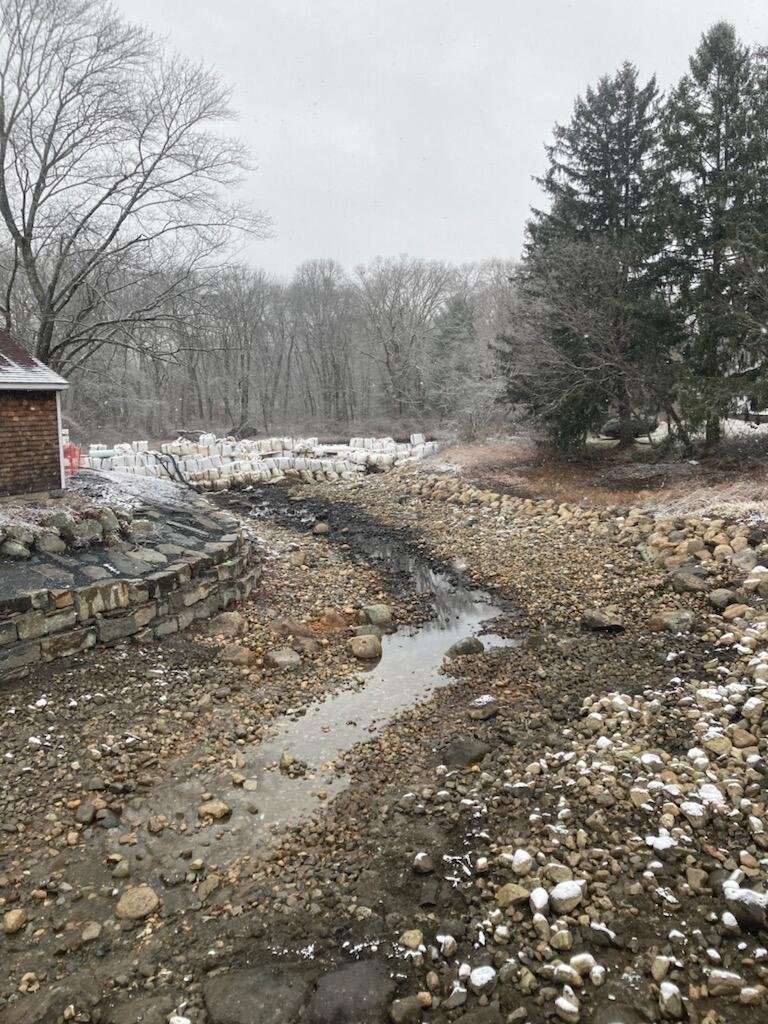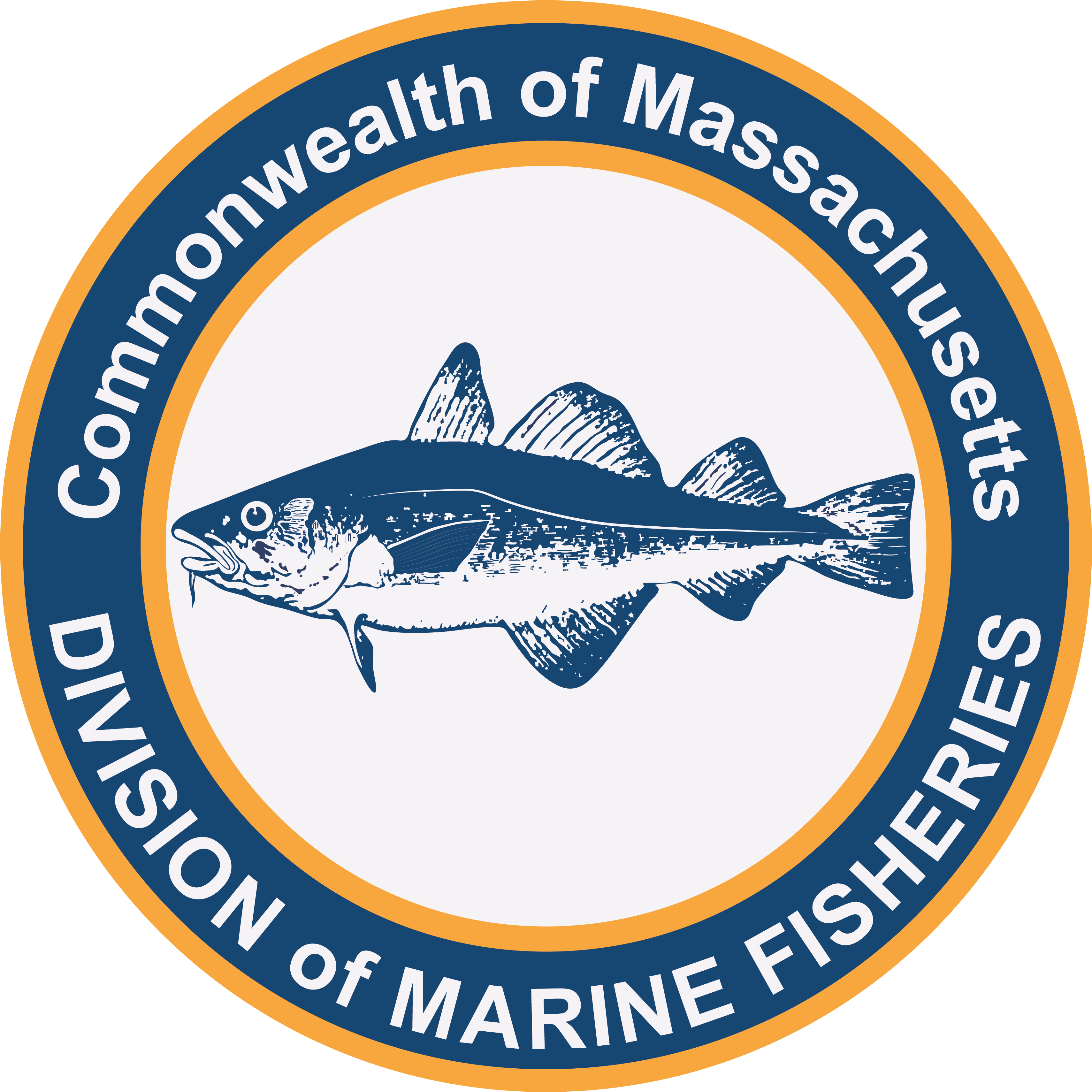- Division of Marine Fisheries

Diadromous, or sea-run fish, are the migratory fish that switch between marine and freshwater habitats to complete their life history. Most diadromous fish populations have declined sharply from historical periods when valuable fisheries were supported. Presently, minor fisheries occur for a few diadromous species and collectively these fish remain important forage for a wide range of fish and wildlife. The DMF Diadromous Fish Project actively monitors river herring, American shad, American eel, and rainbow smelt spawning runs in coastal rivers to contribute to population assessment and management of these species and to inform restoration planning.
River Herring Counts. A river herring harvest ban was implemented by DMF in 2006 out of concern for uniformly declining runs after droughts in 2001 and 2002. Most coastal regions experienced improving spawning run counts soon after with increases during 2012 to 2019 that encouraged public interest. After that, declines and instability were seen in herring counts during 2020-2022 in many coastal rivers. The declines were less apparent on the northern coast of Massachusetts during this period but common for Cape Cod, Buzzards Bay and Narragansett Bay. Improvements in counts were welcome in 2023 for many runs from Cape Cod north, while concerns remain west of Cape Cod.
Our project staff spends much time “counting the beans”. We conduct field monitoring to count the number of river herring, shad, eel and smelt that run up coastal rivers each spring. Additionally, large numbers of volunteers count river herring at over 30 locations each year: a huge effort requiring much coordination and impressive dedication. There was positive feedback in 2023 that offers promise that the counting is contributing to resource management and public goals. Among coastal rivers with counts in 2023, five rivers reached time-series highs in numbers of river herring. These rivers were the Parker River, Newbury; Herring Brook, Pembroke; Town River, Plymouth; Herring River, Wellfleet, and the Marston Mills River, Barnstable. This is a noteworthy as the latter three time-series are 15 years long or more and the Parker River is a 27-year series. Although not time-series highs, the three rivers with the highest 2023 counts in Massachusetts deserve mention for approaching or exceeding the half million fish mark, a modern threshold for a large river herring run: Herring Brook, Pembroke (570,000); Herring River, Harwich (520,000); and the Mystic River, Medford (470,000). When numbers like these run up a river it attracts widespread public attention and is a marvelous harbinger of spring.
One goal with the spring diadromous fish counts is to contribute data to population assessment and management. Five rivers (Mattapoisett River, Monument River, Nemasket River, Parker River, and Town River, Plymouth) contribute river herring counts to the Atlantic States Marine Fisheries Commission stock assessment for river herring. Until 2023, only one of our counting series for American eel, the Jones River Sheldon trap in Kingston, had adequate data quality and duration to be accepted within the ASMFC American eel stock assessment. This year, the eel stock assessment accepted two new series: the eel bycatch in the Fore River smelt fyke net, Braintree, as a yellow eel index of abundance and the Saugus River eel ramp, Saugus, as an elver index of abundance. Reaching this status is a credit to all Diadromous Fish Project staff and local volunteers, past and present, who assisted with these stations. Unfortunately, all three eel indices have significantly declining trends.
Fish Passage Restoration. Every year, numerous fish passage restoration projects are in development both by the DMF Fishway Crew and cooperatively under local, State and Federal partnerships. This past year was also noteworthy for reaching restoration milestones at several locations where passage improvements were long contemplated but challenging to achieve. With limited space to give due credit to an exciting and active restoration scene in Massachusetts now, we will highlight three projects that are reaching the finish line after years of hurdles to hopefully become future examples of increasing counts of river herring and other diadromous fish.
Fore River Watershed, Braintree. Four locations in the Fore River watershed prevented river herring from reaching over 200 acres of natal spawning and nursery habitat for over 200 years. The challenge of providing passage at four locations is further compounded by Great Pond serving as a water supply for three towns. The project began with field investigations over 30 years, and formal discussions with property owners and the water supply and feasibility analyses followed 15 years ago. A fishway was installed at Great Pond in 2017 and this past summer the Armstrong Dam and Ames Pond Dam were removed under a cooperative project led by the Town of Braintree with essential contributions from the MA Division of Ecological Restoration, NOAA Restoration Center, US Fish and Wildlife Service and DMF. The final piece is the construction of a fishway at the scenic Rock Falls slated for this winter. The work is not complete as deliberate planning is needed to provide stream maintenance at key watershed locations and to work with the water supply to get fish in and out of Great Pond. With these fish passage improvements done fish will have the chance to move up the watershed for the first time since the Adams clan cultivated crops and presidents in the great town of Braintree.
High Street Dam, Bridgewater. The High Street Dam on the Town River, a tributary to the Taunton River, was removed this summer. This was another large removal project with over 10 years in the making requiring dedicated funding and efforts from many of the same partners as the Fore River project. In this case, a fishway built in 1919 was present at the dam that allowed river herring to reach the 370 acre Lake Nippennicket. An electronic river herring count was diligently managed here by the Town River Fisheries Committee for 23 years with peak counts occurring early in the time series of between 200,000 and 300,000 river herring. However, the fishway and surrounding dam were in disrepair and removal was the best option for this site in terms of ecological benefits and infrastructure management. The removed dam and reconditioned river channel will allow efficient passage for the target species of herring and eel and hopefully contribute to a resurgence of American shad in the watershed (see report on new Taunton River shad stocking project reported in DMF News Spring 2023).
Stump Brook Reservoir Dam, East Bridgewater. One of the more complex diadromous fish restoration concepts in coastal Massachusetts has been reconnecting fish to the large spawning and nursery habitats of the Monponsetts Pond (528 acres) of the Taunton River watershed and Silver Lake (640 acres) of the Jones River watershed. Many obstructions and alternative uses of surface water have made this concept a restoration Holy Grail to some. Monponsett Pond connects to the east to Silver Lake and drains to the west via Stump Brook. Stump Brook flows to the 168-acre Stump Brook Reservoir and into the 124-acre Robbins Pond which in turn drains to the Satucket River, another Taunton River tributary. In 2010, fish passage was blocked to all of these 1,460 acres of spawning and nursery habitat: easily the largest potential habitat restoration target for river herring in Masschusetts. The wheels started turning when the Wapping Road Dam was removed in the Jones River in 2011 and the Cotton Gin Mill Dam was removed in the Satucket River in 2017. The next step was to provide fish passage at the Stump Brook Reservoir Dam, an impassible dam used for water management at several cranberry farms in East Bridgewater and Halifax. DMF began discussions with the cranberry bog farmer who owns the dam in 2018 and prepared a survey and fishway design in 2021. The Taunton River Stewardship provided a $25,000 grant to DMF to hire GZA to finalize the fishway design and prepare permit applications. DMF staff completed the permit process, provided recycled Alaskan steeppass sections, fabricated the remaining components and installed the fishway during one day this summer working with the bog owner. With material costs, the total project cost was approximately $35,000. Similar to the Fore River project, work is not done given miles of stream channel that has no consideration for fish passage maintenance for decades and the need to work with water suppliers to manage seasonal water flows for fish migrations. This small project involves much more than just an aluminum fishway and river herring. It is another cooperative step towards a multi-generational dream on the resuscitation of priceless and neglected coastal rivers.
By Brad Chase, Diadromous Program Leader
